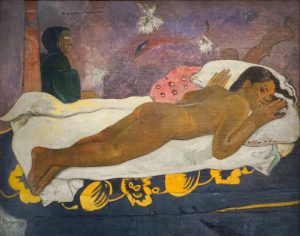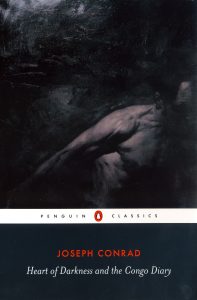Although they may seem like disparate art forms, this essay will reveal the similarities between Gauguin’s painting Manao Tupapau (The Spirit of the Dead Keep Watch) (1892) and Conrad’s novella Heart of Darkness (1899). Many critics have already noted the connection between painting and literature. For example, Schwarz states they can be entwined in various fashions: ‘sometimes art and literature cross-fertilise each other; other times they just take the same source material for a creative act’[1]. Here is an example of the latter, with both men focused upon similar themes, especially ‘primitivism’, a key aspect of modernism. This essay will argue that both use their art to explore the psyche of the West through the ‘primitive’.
Both artists use the idea of the ‘primitive’ in their work. ‘Primitivism’ is key aspect to modernism in its search to subvert traditional forms of artwork; Antliff writes: ‘within the context of modernism, “primitivism” is an act on the part of artists and writers seeking to celebrate features of the art and culture of peoples deemed “primitive” and to appropriate their supposed simplicity and authenticity to the project of transforming Western art’[2].
Gauguin uses the influence of ‘primitive’ cultures. This is partly achieved through the colour blocking and dark contours or ‘cloisonnism’ which is influenced by medieval stained glass and Japanese prints and removes the painting from mimesis[3]. There is also an influence of the art of his adopted Polynesian home, with the ‘kinds of distortions we see in Polynesian sculptures’[4] in his figures. We can see this in the prominence of the facial features and exaggerated hands and feet of the nude also seen in Tahitian statues.
Likewise, Conrad’s use of an oral narrative links to the form of Congolese storytelling, with narratives passed from generation to generation orally and not through written documents[5].
These men can be perceived as anti-colonialist. For example, Conrad shows the futile actions of the French imperialists: ‘we came upon a man-of-war anchored off the coast. There wasn’t even a shed there, and she was shelling the bush…. Pop, would go one of the six-inch guns; a small flame would dart and vanish, a little white smoke would disappear, a tiny projectile would give a feeble screech – and nothing happened. Nothing could happen’[6]. Here the repetition of ‘nothing’ emphasises the futile act, with the assonance of ‘o’ adding to the sense of negation. Indeed, Paul B. Armstrong calls this a ‘daring attack on imperialism’[7].
Similarly, Gauguin seems to honour the culture of Tahiti through mimicking their art forms and representing their mythology, even naming some of his paintings in the Tahitian language. Gauguin went to Tahiti in an attempt to escape civilisation only to find the island almost completely Westernised. He then went to live among locals ‘in a bamboo hut with a thirteen-year-old Tahitian girl as his vahine[8]; he dressed himself like the natives… and tried to familiarise himself with their customs and ways of thought[9]’.
Yet it is clear that these men are appropriating these cultures in a racist manner. Achebe states Conrad ‘is a thoroughgoing racist’[10] by placing the ‘primitive’ as dichotomy to ‘civilised’ Europe, stating that this has gone unopposed as ‘white racism against Africa is such a normal way of thinking that its manifestations go completely unremarked’[11]. There are counter arguments that this is the perspective of the character Marlow, not Conrad, but Achebe feels the layers of oral narrative are designed to provide ‘layers of insulation’[12] for Conrad. Indeed, the racism permeates further than just the representation of African characters (always being seen as the slaves or servants as white men, and denied a voice in a narrative that should be theirs by only having a total of three sentences in the novel) to the narrative itself, as the Congo is used only as backdrop to allow Conrad to explore the psyche of a white European.
Gauguin also uses the primitive to explore the mind of white Europeans. Schwarz sees that ‘anticipating Conrad, Gauguin used the journey to a primitive culture as an opportunity to ask central philosophic questions’[13], exploring the self-aware white European through antithesis with the freedom and innocence of the ‘primitive’. This is seen in his repeated trope of free-loving and unashamed Tahitian women. We see this reflected in figure one in the lack of shame of nakedness, emphasised with the models ‘ample’[14] body, and her direct gaze at the viewer.
In Gauguin’s ‘primitive’ images of ‘pre-fall Eves’[15], he fetishizes the women he portrays, as does Conrad with Kurtz’s ‘savage’ mistress. Both women are displayed as beautiful. Kurtz’s mistress is ‘savage and superb, wild-eyed and magnificent… ominous and stately in her deliberate progress’[16], with the alliteration of ‘s’ mimicking her stately walk whilst creating a relaxed, sinuous sound, and the repeated conjunctions reveal the awe this woman inspires, with single descriptions not enough. Furthermore, Gauguin’s reclining nude mimics classical representations of women in academic art. Yet this beauty is simultaneous with them being a fetishized symbol of the ‘other’, allowing desires to be projected upon them. Conrad makes this woman the ‘symbol of Africa’[17], a ‘land’ with the potential for ownership of white colonists, emphasised in the simile ‘like the wilderness itself’[18]. Gauguin takes this sense of remoteness beyond the physical, with these images being sensual not for ‘the alluring quality of their nudity but their remoteness to the world’[19].
Conrad’s focus on physicality is perhaps because his ‘savage’ doubles Kurtz’s European ‘Intended’, described not bodily but instead through the mind: ‘she seemed ready to listen without mental reservation, without suspicion, without a thought for herself’[20]. Gauguin also references a doubled white woman as he alludes to Manet’s Olympia (1863) through the similarity in composition[21]. By contrast, here the West is used to add a sense of physical sensuality to his work, as he is ‘contriving to invigorate his largely imaginary portrayals of archetypal Tahitian women with that confrontational image of prostitution’[22]. With both calling upon white European women to provide the antithesis of their ‘savage’[23], these artists reveal their thoughts not only about ‘primitive’ women but ‘primitivism’ itself. These foreign art forms and images are invoked only to explore ideas about the West in a sense of crises caused by modernity, as Torgovnick writes, ‘the primitive becomes a convenient locale for the exploration of Western dullness or degeneracy, and of ways to transcend it, and thus functions as a symbolic entity… the primitive responds to the Wests needs’[24].
This essay has shown that these seemingly disparate forms of visual art and literature are in fact incredibly similar, with both even drawing attention to the conceit of the form of their artwork itself. Moreover, these pieces are both used to explore the same theme: the crises of Europe under modernity and the resulting impact upon the psyche of the white European man. The confusion of these men within a modern Europe is explored using the ‘primitive’ as dichotomy, though this is clearly a racist representation. Furthermore, there are some areas where these men use different methods, though ultimately to the same ends: for example, Conrad explores the unconscious through negation where Gauguin uses Tahitian mythology, and Gauguin using a doubled white woman to add a sense of sexuality where Conrad does the opposite. Ultimately, however, the two artworks are innately connected in form, theme, and overall message: although both see ‘the beauty of the jungle and the Tahitian world, they were conscious of its more ominous aspects… which reflected in them the submerged, less attractive elements of the civilised world’[25].
[1] Daniel R. Schwarz, Reconfiguring Modernism: Explorations in the Relationship Between Modern Art and Modern Literature, (New York: St Martin’s Press, 1997) p. 1
[2] Mark Antliff and Patricia Leighten, ‘Primitive’, Critical Terms for Art History, ed. Robert Nelson & Richard Shiff, (Chicago: The University of Chicago Press, 2003) p. 217
[3] Daniel R. Schwarz, Reconfiguring Modernism: Explorations in the Relationship Between Modern Art and Modern Literature, (New York: St Martin’s Press, 1997) p. 80
[4] Daniel R. Schwarz, Reconfiguring Modernism: Explorations in the Relationship Between Modern Art and Modern Literature, (New York: St Martin’s Press, 1997) p. 80
[5] Toyin Falola and Daniel Jean-Jacques, Africa: An Encyclopaedia of Culture and Society, (California: ABC-CLIO, LLC, 2015) p. 307
The Luba people are a major ethnic group found in the DRC, and they are noted to have used oral storytelling for ‘protecting history, genealogy, practices, and traditions of the community’.
[6] Joseph Conrad, Heart of Darkness, ed. Paul B. Armstrong, (New York: Norton and Company, 2006), p. 15
[7] Paul B. Armstrong, ‘Reading, Race, and Representing Others’, Heart of Darkness, ed. Paul B. Armstrong, (New York: Norton and Company, 2006) p. 430
[8] A term for a Tahitian woman, however, Gauguin is clearly married to a child and so perpetuating rape
[9] Ronald Alley, Gauguin, (Middlesex: the Hamlyn Publishing Group, 1968), p. 15
[10] Chinua Achebe, ‘An Image of Africa’, Heart of Darkness, ed. Paul B. Armstrong, (New York: Norton and Company, 2006), p. 343
[11] Ibid, p. 343
[12] Ibid p. 342
[13] Daniel R. Schwarz, Reconfiguring Modernism: Explorations in the Relationship Between Modern Art and Modern Literature, (New York: St Martin’s Press, 1997) p. 83
[14] Belinda Thomson, Gauguin: Maker of Myth, (London: St Ives Westerham Press, 2010) p. 178
[15] Belinda Thomson, Gauguin: Maker of Myth, (London: St Ives Westerham Press, 2010) p. 152
[16] Joseph Conrad, Heart of Darkness, ed. Paul B. Armstrong, (New York: Norton and Company, 2006), p. 60
[17] Marianna Torgovnick, ‘Primitivism and the African Woman’, Heart of Darkness, ed. Paul B Armstrong, (New York: Norton and Company, 2006), p. 403
[18] Joseph Conrad, Heart of Darkness, ed. Paul B. Armstrong, (New York: Norton and Company, 2006), p. 60
[19] Murray Roston, Modernist Patterns in Literature and the Visual Arts, (London: Macmillan Press, 2006) p. 90
[20] Joseph Conrad, Heart of Darkness, ed. Paul B. Armstrong, (New York: Norton and Company, 2006), p. 74
[21] Both images feature a reclining nude upon a bed, gazing at the viewer, with a figure in the background to the opposite of the nude; the nude herself stares directly at the viewer, compromising the male gaze
[22] Belinda Thomson, Gauguin: Maker of Myth, (London: St Ives Westerham Press, 2010) p. 151
[23] Joseph Conrad, Heart of Darkness, ed. Paul B. Armstrong, (New York: Norton and Company, 2006), p. 60
[24] Marianna Torgovnick, ‘Primitivism and the African Woman’, Heart of Darkness, ed. Paul B Armstrong, (New York: Norton and Company, 2006), p. 401
[25] Murray Roston, Modernist Patterns in Literature and the Visual Arts, (London: Macmillan Press, 2006) p. 37


